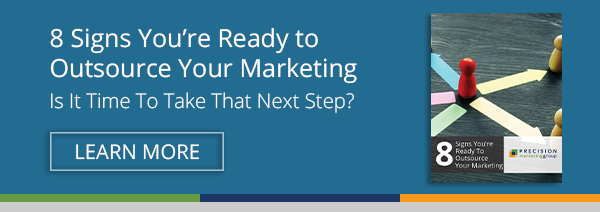Considering outsourced marketing for your tech company? There’s a lot to weigh when searching for the right digital marketing firm. Even after finding the best-fit marketing partner, what can you expect in those first few months and beyond?
It’s important to know that the first few phases of your relationship are essentially a “building” phase. Your marketing program will only run as smoothly as the foundation you lay at the outset — and just like with any relationship, setting expectations is key.
In this blog, we’ll fill you in on what you need to know. We’ve broken it out into 5 distinct "relationship" phases, and strategies throughout each phase that will set you up for a long and successful engagement.
- 1. Find the right digital marketing firm
- 2. Define responsibilities and establish protocols
- 3. Set your marketing goals
- 4. Understand billing practices
- 5. Maintain the agency relationship
-
1. Find the Right Digital Marketing Firm for Your Tech Company (Dating Phase)
Finding a good agency is a little like online dating. So far, the RFP process has not evolved to the point of a simple swipe — but you can trust us that you’ll want to go a lot deeper than that! Polished presentations can dazzle you upfront, but there are far better ways to tell when an agency is potentially a good or bad fit.
First clue: industry expertise. Has the agency worked with tech companies like yours before? There are dozens of organizations that fall under the umbrella of “tech” – from IT, to FinTech, to emerging technologies— and that’s just the tip of the iceberg.
You’ll want to partner with someone who “gets” your unique business, your customers, and the detailed nuances of your industry. Don’t be afraid to inquire about an agency’s past and existing client base. Also, ask if they have tech-specific talent on staff -- for example, specialized writers and tech-savvy account managers.
Consider the “softer” qualities as well when speaking with potential agencies. How do your engagements make you feel? Are you excited and empowered after every call —or anxious and feeling vague? Does it seem like your challenges and goals are being heard, and played back in conversations?
Remember to lean into your gut feeling. Many agencies can wow you with an impressive presentation upfront, but it’s the quality of your day-to-day interactions that matters most.
2. Define Responsibilities & Establish Protocols (Engagement Phase)
Once you’ve chosen the right agency and all the necessary paperwork is signed, the hard work is over, right?
Not so fast.
The first few months of your engagement can set the tone for what will hopefully be a long-term partnership. Now is the time to determine who owns what and to set the protocols to make your engagement seamless.
If you have an internal marketing manager, this process may be a bit simpler. Either way, you’ll want to think about the following questions:
- Who is the main point of contact internally for your marketing?
- How many levels of edits/revisions are necessary before something can be signed and sealed? ( i.e., does a blog need to go through you, your manager, and legal before being posted?)
- Who will manage the revision process for the creation of that new content?
- Who will be your backup contact when your point person is out of the office?
- How often do you want to set up calls or meetings with your agency?
- How frequently should your marketing contact reach out to you?
- What are your general communication preferences? (i.e., texts, emails, phone calls)
- Should your firm be introduced to other individuals or departments so they have everything they need to be successful? (i.e., are there individuals who are SMEs on especially complex tech topics? Co-marketing opportunities via partners?)
During this phase, Account Managers will be determining how much communication is too much (and too little). For example, if you value extra nudges and reminders, or 30 minutes maximum is "the sweet spot" for weekly meetings, be sure to let them know.
There will always be a few bumps at the beginning of an engagement – but if you are open and communicative at the outset, you’ll set the right expectations and hit your groove in no time.
3. Set Your Marketing Goals (Honeymoon Phase)
During this phase, you should see the needle start to move – and it’s exciting! It's a good time to evaluate how well your goals are being met in the relationship.
As a tech company, it is unlikely that you have your “marketing goals” nailed down and documented. But surely you have a few big-picture priorities for your business -- and that's a great starting point. Here are just a few examples:
- Next year, I want to increase the revenue of my existing client base by X%.
- By Q4, I want to increase our new customers by X%.
- I would like to attract XX attendees for an upcoming technology conference.
- Each month, I would like XX prospects to sign up for a product demo.
Here’s what many business leaders don’t always realize: your marketing goals are often just a way to accomplish your business goals. More about that here: How to Set Business Goals and Achieve Them (With Marketing).
Within your first 90 days, your marketing partner should help you lay the groundwork for both short- and long-term marketing goals, with actionable steps to make them happen. Expect them to provide insight into what’s realistic when it comes to timelines. Then they should formulate the best marketing strategies to see those goals though, providing regular updates along the way.
Remember: agencies can never hit goals that are not well-defined – and without setting expectations, your tech company will have no real measure for success.
4. Understand Billing Practices (First ‘Finances’ Discussion)
Ah, the dreaded money conversation. Even the best relationships can be brought down by financial issues. Outsourced marketing relationships are no different – but with good, transparent communication, this issue is completely avoidable.
Before you begin an engagement with an agency, it’s critical to understand their billing practices and their average cost for projects. If you want to publish two blogs per month, but you’re not willing to spend more than $500 on blogging, you’ll find yourself at an impasse. Be sure you have such discussions during the Dating Phase!
Some agencies will work with you on a monthly budget, and put together a plan that falls within your price range.
Others will be far too expensive for you to use for larger projects… meaning you would have to find another outside partner to supplement certain projects. Or you may need to reevaluate your yearly budget.
Again, be transparent with your partner about your budget limitations before you begin the engagement to make sure that you’re able to allocate enough funds to reach your goals.
5. Maintain the Agency Relationship (Keep the Magic Alive Long-Term)
All relationships take some work, and business relationships are no different. If you’ve selected your outsourced marketing partner well, you shouldn’t have to go back to the drawing board when things start feeling stagnant.
Here again, communication is key. If you’re feeling that over time, your marketing program is losing momentum or getting stale, then have discussions about how to shake things up.
One way? Ask your agency to present to you a “blue sky” marketing plan – meaning if the budget wasn’t an issue, what would they do or recommend? This presentation should offer you a few options at different price points that will help keep your program fresh over time.
Blue sky projects can be as big as a website redesign or as small as a new paid advertising campaign. Giving your agency free rein to think creatively can provide fresh ideas for all budgets and timelines.
If you think that your strategy has run its course, don’t automatically start looking for a new partner; instead, look for a new perspective. What new marketing technology has emerged that you can incorporate? What projects have been successful in the past? Go through your ideas with your agency and give them the time to prepare a few of their own for you. Your combined efforts may breathe new life into your program.
Most importantly, don’t be afraid to experiment. Marketing is often a mix of both science and creativity. And while there may be data to bolster your ideas, that won’t eliminate the risk. Be willing to try new initiatives and develop alternative programs that will work for your business.
Set Up for Marketing Success
Digital marketing for tech companies is not rocket science. An experienced marketing firm will know what works, what doesn’t, when to pivot, and how to help you reach your goals.
Still, no matter how knowledgeable you are about your tech business, or how experienced your marketing partner may be, partnerships must be tended to at every phase of the relationship to ensure long-term success.
Here are a few more resources to help you decide on the best marketing option for your tech business:
And of course, don’t hesitate to reach out to us if you have any questions! We may not be able to give you relationship advice, but we can certainly help with your marketing.











